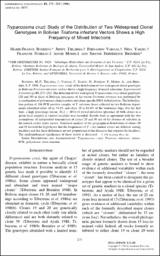Trypanosoma cruzi : study of the distribution of two widespread clonal genetypes in Bolivian Triatoma infestans vectors shows a high frequency of mixed infestions

View/
Date
1996Author
Bosseno, Marie-France
Telleria, Jenny
Vargas, Fernando
Yaksic, Nina
Noireau, François
Morin, Annie
Brenière, Simone Frédérique
Metadata
Show full item recordAbstract
Abstract.
The detection of two widespread Trypanosoma cruzi clonal genotypes (20 and 39) in feces of Bolivian specimens of the vector Triatoma infestans was performed by a combination of polymerase chain reaction and clone-specific DNA hybridization. The hybridization pattern of 186 PCR positive samples of T. infestans feces collected in two Bolivian departments identified clone 20 in 74.2% and clone 39 in 63.4% of the triatomine bugs. For the first time, a high percentage (mean: 43.2 +-26%) of mixed infections (presence of both clones in a given fecal sample) in various localities was recorded. Results were in agreement with the two assumptions of independent transmission of clones 20 and 39 and of the absence of selection in the natural cycles under survey. Statistical analysis of the geographical distribution of clones 20 and 39 favored the hypotheses that the frequencies of T. cruzi natural clones are different among localities and that these differences are not proportional to the distances that separate the localities. The epidemiological significance of these results is discussed.
